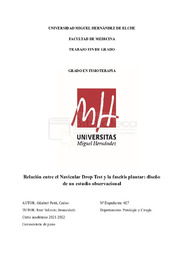Por favor, use este identificador para citar o enlazar este ítem:
https://hdl.handle.net/11000/28227
Relación entre el Navicular Drop Test y la fascitis plantar: diseño de un estudio observacional
 Ver/Abrir: TFG.pdf
Ver/Abrir: TFG.pdf1,31 MB
Adobe PDF
Compartir:
Título :
Relación entre el Navicular Drop Test y la fascitis plantar: diseño de un estudio observacional |
Autor :
Gilabert Ferri, Carlos |
Tutor:
Ruiz Valiente, Inmaculada |
Editor :
Universidad Miguel Hernández |
Departamento:
Departamentos de la UMH::Patología y Cirugía |
Fecha de publicación:
2022-06-20 |
URI :
https://hdl.handle.net/11000/28227 |
Resumen :
Introducción
La fascitis plantar es una patología de origen degenerativo y crónico que se caracteriza por dolor en la
cara medial del talón. Uno de los factores de riesgo que aumenta la incidencia de esta lesión es la
debilidad de la musculatura intrínseca del pie. Dicha musculatura es la encargada de mantener la
altura dinámica del arco longitudinal medial la cual se puede medir mediante el Navicular Drop Test
(NDT). El objetivo de este estudio es establecer una relación entre la fascitis plantar y el NDT.
Métodos y análisis
Se trata de un estudio observacional analítico de carácter transversal en el que se incluyen a
corredores mayores de 40 años. Se les medirá el NDT a los participantes y se les dividirá en dos
grupos según los resultados que obtengan, 154 sujetos con el test positivo y 978 con el test negativo.
Posteriormente, a todos ellos se les realizará una valoración con el fin de determinar cuales padecen
fascitis plantar. Se realizará un análisis estadístico mediante la prueba de chi cuadrado con el fin de
determinar si existe asociación entre el grupo que presenta un NDT positivo y el grupo diagnosticado
con fascitis plantar.
Resultados esperados
Se espera obtener una mayor proporción de sujetos que padezcan fascitis plantar en el grupo del NDT
positivo, estableciendo una relación sin efecto de causalidad entre ambas variables.
Introduction
Plantar fasciitis is a pathology of degenerative and chronic origin, which is characterized by pain in
the medial side of the heel. One of the risk factors that increases the incidence of this injury is the
weakness of the intrinsic foot muscles. This musculature is responsible for maintaining the dynamic
height of the medial longitudinal arch, which can be measured by the Navicular Drop Test (NDT).
The aim of this study is to establish a relationship between plantar fasciitis and the NDT.
Methods and analysis
This is a cross-sectional analytical observational study involving runners over 40 years of age. The
participants will be measured with the NDT and will be divided into two groups according to the
results obtained, 154 subjects with the positive test and 978 with the negative test. Subsequently, all of
them will be evaluated in order to determine which of them suffer from plantar fasciitis. A statistical
analysis will be performed using the chi-square test in order to determine if there is an association
between the group with a positive NDT and the group diagnosed with plantar fasciitis.
Expected results
It is expected to obtain a higher proportion of subjects suffering from plantar fasciitis in the group
with a positive NDT, establishing a relationship without causality effect between both variables.
|
Palabras clave/Materias:
Fascitis plantar
Navicular drop test
Musculatura intrínseca del pie
Arco longitudinal medial |
Área de conocimiento :
CDU: Ciencias aplicadas |
Tipo documento :
application/pdf |
Derechos de acceso:
info:eu-repo/semantics/openAccess
Attribution-NonCommercial-NoDerivatives 4.0 Internacional |
Aparece en las colecciones:
TFG - Fisioterapia
|
 La licencia se describe como: Atribución-NonComercial-NoDerivada 4.0 Internacional.
La licencia se describe como: Atribución-NonComercial-NoDerivada 4.0 Internacional.
 La licencia se describe como: Atribución-NonComercial-NoDerivada 4.0 Internacional.
La licencia se describe como: Atribución-NonComercial-NoDerivada 4.0 Internacional.
.png)
